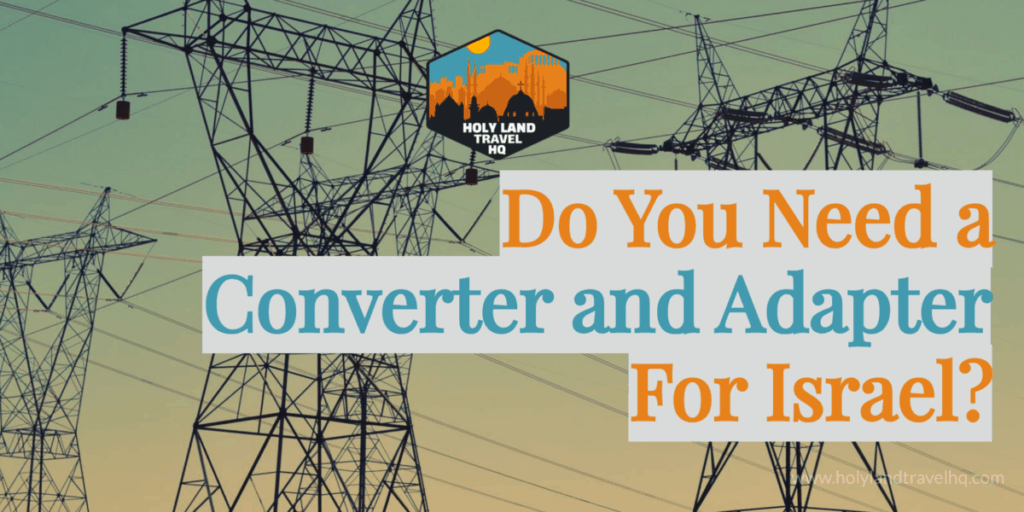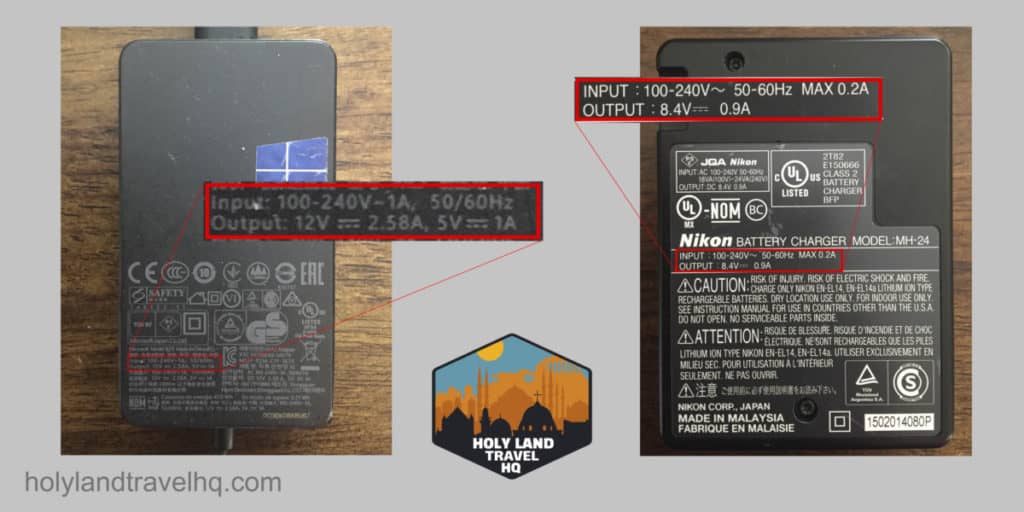
We’ve all heard the stories about electronics burning up when someone plugs something into a foreign electrical outlet. These things do happen, but they can be avoided if you understand a few things about electricity.
The big question, though, is do you need a converter and adapter for Israel? You do not need a converter for most electronic devices, but you will need an adapter. There are 3 different plug prong configurations used in Israel. The C-type, H-type, and M-type. All differ from the two and three pronged plugs (A- and B-type) used in the United States.
Generally, the plug prong configurations used in Europe are the same used in Israel.
In the United States the electric rating is 120 Volts at 60 Hertz. In Israel, the electric rating is 230 volts at 50 Hertz. Which is also what Europe uses.
Because electronic companies mass produce, they want to avoid waste by manufacturing different versions of products. As a result, most mobile electronic devices these days can take both electric ratings.
Lastly, some older devices may be limited to 120V and will required voltage conversion.
All links are direct links.
What you need to know about electricity.
Voltage is the amount of electricity provided by the power source. It is measured in Volts.
Current is the speed at which electricity moves through a wire. It’s measured in Amps.
We aren’t going to get into Frequency, which is measured in Hertz. It gets too complicated and it’s not something you really need to know. The only thing to be aware of is that it will affect the accuracy of a clock. If you do use some kind of alarm clock, use a battery powered travel clock.
When you multiply Voltage times Current, you get Power. Power is measured in Watts. You want to know this when figuring out your electrical needs.
Also, even though the source of power is really the grid, for our purposes we’ll say the source is the outlet.
Understand that electricity is not being pushed to your device from the source. The device is pulling electricity from the source.
What does this mean for your device?
So, back to the stories of electronics burning up. If your device is only designed to pull from a 120V source, it will always think it’s pulling from a 120V source. So, when you plug it into a 240V source, the device may get overloaded.
I once blew the charging cord for some portable speakers because I didn’t check the label. It was only capable of pulling from a 120V source.
A good way to imagine this is if you pick up a glass of water and its actually vodka. You were expecting something tasteless without any potency, but you got something else.
Because most electronics these days are capable of taking 100V and 240V, you will be fine.
The bigger problem is the power rating of the outlet. If your device pulls more voltage and current than the outlet’s power rating, the outlet will burn up or trip a breaker. An outlet’s power rating is determined by
- the voltage provided to it by the grid (120V in the US and 230V in Israel).
- the current allowed by the outlet’s circuit breaker at the panel (usually 15 or 20 Amps in the US).
Outlets in the United States provide between 1,800 to 2,400 Watts. An iPhone typically draws less than 5 Watts (5V at 1 Amp). An iPad draws less than 10 Watts (5.1V at 2.3 Amps).
Hair dryers are where you will have problems. They draw between 1,500 and 2,000 watts. Which is why bathroom outlets typically get a dedicated 20 Amp circuit breaker.
The outlets you will find in Israel may or may not be rated for high wattage. Or have a dedicated circuit breaker. Which is why there are so many travel horror stories about electricity.
Adapters versus Converters.
An adapter does not convert electricity. It merely allows you to plug your United States three prong electrical cord into a foreign outlet. So, 240V will not get changed to 120V.
Also, adapters have power limitations. A standard iPhone USB adapter is rated up to 5 Watts. It can handle your iPhone, but not a hair dryer.
A converter changes the characteristics of the electricity. It will either step the voltage down or up. Some do both. Converters are sometimes called Voltage converters, Power converters, or transformers. So, keep that in mind.
Converters also have power ratings. They convert voltage, but not current. So, when you buy a converter, you are paying for how much Power (Watts) it can handle. The more power it can handle, the more wiring it needs. Which means they get heavier and more expensive as the power rating goes up.
A 100-Watt converter might cost you $20 and weigh 5 pounds. A 2,000-Watt converter might be $150 and weigh 50 pounds.
I used to lug a 2,000-Watt converter with me on deployment. It took up room in my case, as well as my weight allotment. The only reason why I used a converter on deployment was because we were on generator power. Generators often have power fluctuations; a hefty converter can bear the brunt of those surges.
Why you need an adapter, but not a converter.
Most mobile electronics can handle voltage between 100V and 240V. So, there is no need to convert the electricity coming out of the outlet. But if you do get a converter, there is something to be aware of.
When a device attempts to pull more power than a converter can handle, the excess electricity will escape through the converter. I know this from experience. I once plugged a 900-Watt George Forman Grill into a 300-Watt converter. The ball of flames almost set my barracks room on fire. But the grill was just fine.
All you need is an adapter that can fit your United States 2 or 3 prong cord into the foreign outlet.
When looking at adapters, they are not all equal though.
What kind of adapter should you buy?
There are two styles of adapters.
The first style is the universal adapter. These devices are typically all-in-one tools. They have levers and switches that change the prongs for the region you need.
The receptacle holes are often a combination of all the outlet options from around the world. Whatever plug type you have, it’ll fit.
Universal adapters have too many moving parts for my taste. This means there are ample opportunities for the adapter to fail or break.
Universal adapter receptacles (the holes you plug the prongs into) tend to lose grip strength quickly. You might find yourself holding a cord at a certain angle so it can get charged. Or the constant moving around will cause crackling sounds from making contact and releasing contact.
I’ll call the second style the basic adapter. Basic adapters typically have a set of attachable prongs on the back for each region of the world. The receptacles on the face are for a single region only, such as the United States or Europe.
Basic adapters have no moving parts because region specific prongs are attached as needed. They aren’t perfect, but in my experience, they are more reliable than universal adapters.
Another advantage to basic adapters is the fact that their receptacles are for one region only. This means the receptacles are often tight. So, you shouldn’t have to worry about holding a cord at a specific angle to make a connection.
To see what I use, check out my gadget recommendations right here. The Ceptics travel adapter that I use worked just fine, without a converter, in Israel as well as Europe.
Do European plugs work in Israel?
The most common plug type in Europe is the C-type plug, which is also the main plug type found in Israel. You may also find the H-type and M-type of plugs in Israel. Though they are less common, I recommend getting an adapter to handle those types. .
The electric grid in Europe is 230V and 50 hertz, just like Israel. So, you won’t need to fret over voltage conversion issues.
For an exhaustive list of countries and their plug types, check out this British run website called Electrical Safety First.
How to find out what your device’s power rating is.
If you have an Apple device, its range is 100V to 240V and 1 to 3 Amps. You can verify your specific device’s requirements by checking the manual. Or you can check out this page at Apple.com.
For all devices, including Apple devices, power ratings are on the device itself or the electric cord that came with it. If the power rating is on the device, it is usually next to where you plug the power cord into. Or the bottom of the device.
Here are some examples of where power ratings have been placed. The writing is almost always so small you need a magnifying glass to see it.

For both of the items in the picture, the INPUT is what they are capable of pulling from the source. Which is 100V to 240V at 50-60 Hertz.
The OUTPUT is what the device pulls in order to charge. For the power cord on the left, it charges the device and has a USB outlet. So the first rating, 12V at 2.58A is for the device. When connected it pulls 30.96 Watts. The second rating, 5V at 1A, is for the USB outlet. It pulls 5 Watts.
For the battery charger on the right. It pulls 8.4V at .9A. So, 7.56 watts.
What about unique items, such as medical devices?
CPAP machines typically draw 30-60 Watts to charge. And most of them can take 100V to 240V. But you should verify that.
Mobility scooters use 250-300 watts in order to charge. This isn’t a lot, but you still want to make sure your scooter can handle foreign electricity. Verify the rating on the charging device.
If you have a mobility scooter, you might want to consider renting one if possible.
For more information on accessible Holy Land Tours, check out a post I wrote on the topic right here.
For any medical device, have a backup plan. Extra batteries. An extra charger. or maybe even a converter.
For a medical device that uses less than 100 watts. I would still recommend getting a 200- or 300-watt converter. Just to be safe.
Remember, converters are sold based on the wattage they provide. So, you will need to ask for, or Google, “300-watt power converter for sale” or “buy 100-watt converter.”


